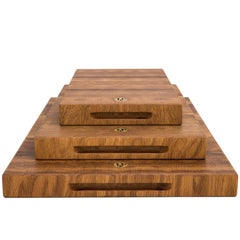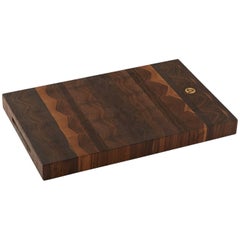Wesley Butcher
Recent Sales
2010s American American Craftsman Butcher Blocks
Hardwood
2010s American American Craftsman Butcher Blocks
Hardwood
2010s American American Craftsman Butcher Blocks
Hardwood
2010s American American Craftsman Butcher Blocks
Hardwood
2010s American American Craftsman Butcher Blocks
Hardwood
2010s American American Craftsman Butcher Blocks
Hardwood
A Close Look at american-craftsman Furniture
Inspired by the Arts & Crafts style in England, which rebelled against the mechanization of the Industrial Revolution with a proud emphasis on handcrafted design, American Craftsman style similarly pushed against the lavishness of the Victorian era. Coined by Wisconsin-born Gustav Stickley, a furniture designer and publisher of The Craftsman magazine, American Craftsman furniture would influence homegrown styles that followed, such as Mission and the Prairie School.
Like the popular early 20th-century Craftsman houses — which feature meticulous woodwork on everything from built-in bookcases in the living room and cabinetry in the kitchen to earth-toned exteriors with exposed rafters — American Craftsman furniture was all about handmade storage cabinets, bedroom furniture, chairs and other pieces built with organic materials. “Simplicity and straightforwardness of construction has always been the leading characteristic of Craftsman furniture,” Stickley stated. And while he is often credited with most of the designs at the Craftsman Workshops in Eastwood, New York, others such as Harvey Ellis were influential in shaping the straight-backed chairs, beds with vertical slats and tables with exposed joinery that came to define the style.
Highly utilitarian with no unnecessary flair, American Craftsman furniture was designed to emphasize the essence of its modest construction and promote the natural beauty of the wood. Solid oak, cherry, walnut and mahogany were all favored by the movement’s principal figures. Another attribute commonly associated with the style is the integration of subtle details like tooled leather, inlaid metal and hammered iron handles.
Owing to the outbreak of World War I, the popularity of American Craftsman style waned as consumer spending dropped and furniture companies shifted to the production of wartime materials and goods specified in government contracts. Yet, by the 1960s, there was a renewed appreciation for this foundational modern American style, with Stickley and his contemporaries in demand for the clean, simple lines and sturdy construction of American Craftsman furniture.
Find a collection of antique American Craftsman chests, nightstands, seating, decorative objects and more furniture on 1stDibs.
Finding the Right butcher-blocks for You
For the culinary star in your home, an antique or vintage butcher block is an indispensable accessory. Whether it’s a stand-alone table or island, a feature atop your rolling kitchen cart or a countertop application, this is a specific type of assembled wood surface for important food prep needs.
A butcher block is a designated work surface in a kitchen. Specifically, a butcher block affords you a strong and sturdy surface on which you can butcher meat as well as slice and dice vegetables. Having a designated area for this kind of work will help keep the kitchen sanitary and prevent potential damage to countertops.
Because wood is difficult to clean, stains easily and is an ideal surface for bacteria to flourish, counters were traditionally capped with metal. Butcher block — which, as a descriptor, refers to a specific material that is biodegradable and eco-friendly — was initially used in a commercial capacity but began to materialize in the early 20th century as countertops.
Butcher block is made from straight slats of wood that are glued together into thick slabs. The varieties include cherry, walnut, maple and oak. (The latter should be varnished or lacquered.) Construction types vary for butcher block countertops: There is edge grain (parallel boards that show their “edges”), end grain (small square pieces aligned vertically so that the “ends” are visible) and blended (with no specific pattern).
And there is a difference between a butcher block and a cutting board: A board in your kitchen that is used every day for slicing fruits and vegetables is generally called a cutting board. A more robust board — specifically, those that are constructed in the manner mentioned here — is a butcher block, which will be more appropriate for chopping meat as well as deboning.
The extensive collection of butcher blocks on 1stDibs includes French Provincial butcher blocks, rustic butcher blocks and more.

